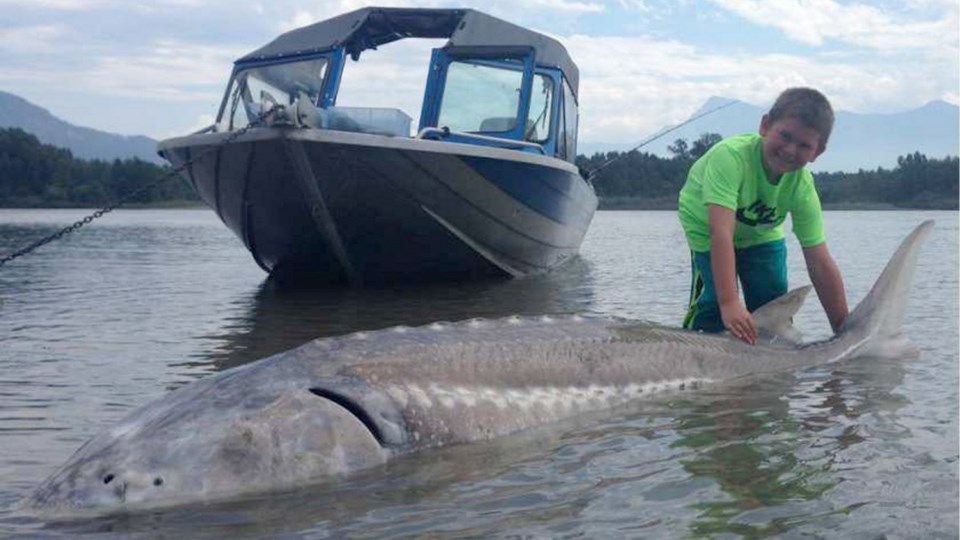A new international study is raising serious questions about a lucrative catch-and-release sport fishery for threatened white sturgeon in the lower Fraser River.
The Canadian-led study, published in the online journal Conservation Physiology, simulated fishing conditions using 24 wild-but-captive sturgeon in winter and 24 in summer at a U.S. Fish and Wildlife Service facility in Longview, Washington .
The results found that sturgeon suffered wide-ranging physiological stress and some even died during the experiment. Researchers noted that actual fishing conditions could be worse due to warmer summers in the lower Fraser River and the potential for some large sturgeon to be played for more than two hours before being reeled in.
The study called for further research and raised the spectre of fishing restrictions in summer, at a minimum, when sturgeon are most vulnerable to catch-and-release fishing. It also suggested that there is little science to support catch-and-release sport fishing for the species.
“Despite the growing popularity of recreational fishing for white sturgeon, there has been limited published work focusing on the potential impacts of acute angling stressors,” the study notes.
BCIT fish and wildlife instructor Marvin Rosenau, a former director of the Fraser River Sturgeon Conservation Society, said that while overall stocks in the lower Fraser seem stable, there are concerns about declining juvenile populations.
The fear is that large females could be reabsorbing their eggs into their bodies due to the stress of repeatedly being caught and released in the sport fishery, he said.
“It’s a pretty sensitive subject,” he said. “I’ve given a number of talks over 10 years … and invariably somebody asks:‘Why are governments allowing catch-and-release angling of an endangered species?’
“I don’t really have a response to that. Every fish is on average being caught at least once a year in the lower river. We have to ask whether it is appropriate,” especially in warm temperatures, given the new study.
Greig Bethel, spokesman for the Ministry of Forests, Lands, and Natural Resource Operations, estimated there are more than 49,000 sturgeon in the Fraser River province-wide, up from 45,000 in 2012.
About 16,000 sturgeon licences are sold each year for the lower and middle Fraser. The ministry is currently evaluating the number of white sturgeon caught and released in the recreational fishery through a mail-out survey to licence holders, but it believes mortality is low, Bethel said.
A sturgeon-fishing outfit near Lillooet, River Monster Adventures, charges $875 plus tax per person for a day trip.
Owner Jeff Grimolfson said area guides work for conservation, tagging hundreds of sturgeon in co-operation with the society. From what he sees, the population is healthy and not jeopardized.
Some sturgeon have been caught close to 30 times, he said, and plenty of young fish are showing up. Two of his boats caught a total of 41 sturgeon in one day this week.
“If they were so endangered you wouldn’t be seeing those.”
He added he wouldn’t be surprised if the B.C. sturgeon fishing industry is worth $50 million annually.
The aboriginal Lower Fraser Fishing Alliance is urging the province to suspend the catch-and-release fishery, saying it is “undoubtedly causing stress that may lead to reduced reproductive capability and potentially death.”
Alliance chairman Ken Malloway urged more regulations for the 365-day-a-year fishery, especially in spawning areas.
“Just because it doesn’t die, it doesn’t mean no harm is done,” Malloway said. “How about if I torture and release you?”
The industry is heavily invested in sturgeon fishing, believes it is the best steward of the fish and is against any restrictions, he said.
“White sturgeon doesn’t mean it’s just for white people,” Malloway added. “We’ve lived on them forever.”
The lead author of the latest study is Montana McLean of the Department of Biology at Dalhousie University, Halifax. Scott Hinch of the department of forest and conservation sciences at the University of B.C. and David Patterson of Fisheries and Oceans Canada and the Cooperative Resource Management Institute also participated.
Mark Angelo, rivers chairman of the Outdoor Recreation Council of B.C., said that “given the angling pressure on sturgeon that exists in the present catch-and-release fishery, this study… highlights the need for more research because little is known about the effects.”



